Indian Ocean is the third largest water body in the world. Sometimes, the Indian Ocean is also known as ‘sea of stability’. Indian Ocean is a lifeline to the international trade and transport as it carries one third of the world’s bulk cargo traffic and two thirds of the world’s oil shipments. Indian Ocean contains a great degree of wealth in the form of abundance of oil, natural gas, minerals. The region constitutes the lifeline to drive the economic vibrancy in Asia and Europe.
The strategic and economic pivots are shifting to make the Indo-Pacific generally, and the Indian Ocean Region (IOR) more specifically the centre stage of virtually every major power. However, while the attention of other countries on IOR is fairly recent, India has maintained trade and civilizational links with other countries in the region since the time immemorial. These links were developed without recourse to military conquest, instead by people-to people engagements.
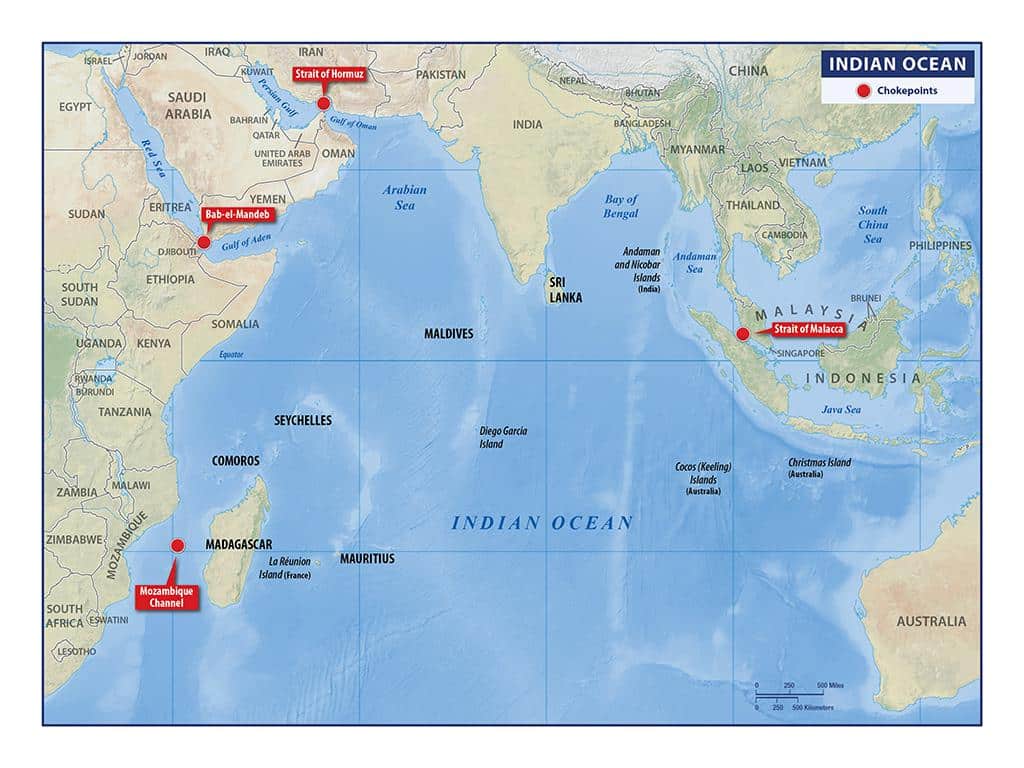
Significance of Indian Ocean
The Indian Ocean basin is of particular importance for India as the region’s most populous country and geopolitical keystone. India’s 90% of trade by volume and almost all oil imports come via sea route which underscores the significance the region.
Economic
- The Ocean is a valuable source of mineral and oil resources. Forty per cent of the world’s offshore oil production takes place in the Indian Ocean basin. India is also the fourth-largest importer of liquefied natural gas (LNG), with about 45 per cent coming by sea.
- The sea lanes in the Indian Ocean are considered among the most strategically important in the world which sustain Asia’s largest economies including India.
- Securing Sea lanes of Communication: In the Indian Ocean, three major Sea Lanes Of Communication (SLOCS) play a crucial role in the energy security and economic prosperity:
- SLOC connecting the Red Sea to the Indian Ocean through the Bab al-Mandab (that transports the bulk of Asia’s international trade with its major trading partners in Europe and America),
- SLOC connecting the Persian Gulf to the Indian Ocean through the Strait of Hormuz (transporting the bulk of energy exports to major import destinations like India, ASEAN, and East Asia),
- SLOC connecting the Indian and Pacific Oceans through the Straits of Malacca (integral to the smooth flow of trade with ASEAN, East Asia, Russia’s Far East and the US).
- Securing Sea lanes of Communication: In the Indian Ocean, three major Sea Lanes Of Communication (SLOCS) play a crucial role in the energy security and economic prosperity:
- Fishing in the Indian Ocean accounts for almost 15 per cent of the world’s total.
- The Indian Ocean region transports 75% of the world’s maritime trade and 50% of daily global oil consumption.
Deep Sea Exploration
- In 2002, International Seabed Authority under UNCLOS granted permission to India to explore ocean regions and prospect for precious metals.
- Deep seabed polymetallic sulphides (PMS) contain iron, copper, zinc, silver, gold and platinum in variable constitutions.
Strategic and Security
- India has a coastline of about 7500 km, and a large population is dependent on the fishing sector. Therefore, the security in the region is vital for coastal security as well as economic development.
- Terror attack in Mumbai stresses the need to ensure the security of the region.
- The region is a witness to continually evolving strategic developments including the competing rises of China and India, the US interventions in Iraq and Afghanistan, potential nuclear confrontation between India and Pakistan, terrorism, piracy in and around the Horn of Africa.
- The Straits of Hormuz, Malacca, and the Bab el Mandeb are some of the choke points. These choke points are strategically important for global trade and energy. Countries like USA, France and others maintain a naval presence in the Indian Ocean.
- China’s special emphasis towards Indian Ocean (through its Silk Road project and growing cooperation with the littoral nations) as well as its formation of the blue water navy increases the importance of the region.
- ‘Pivot to Asia’ policy of USA and ‘OBOR & String of Pearls of China’ has increased the strategic significance of the region.
- The docking of Chinese warships and submarine in Hambantota sent a disquieting signal for India.
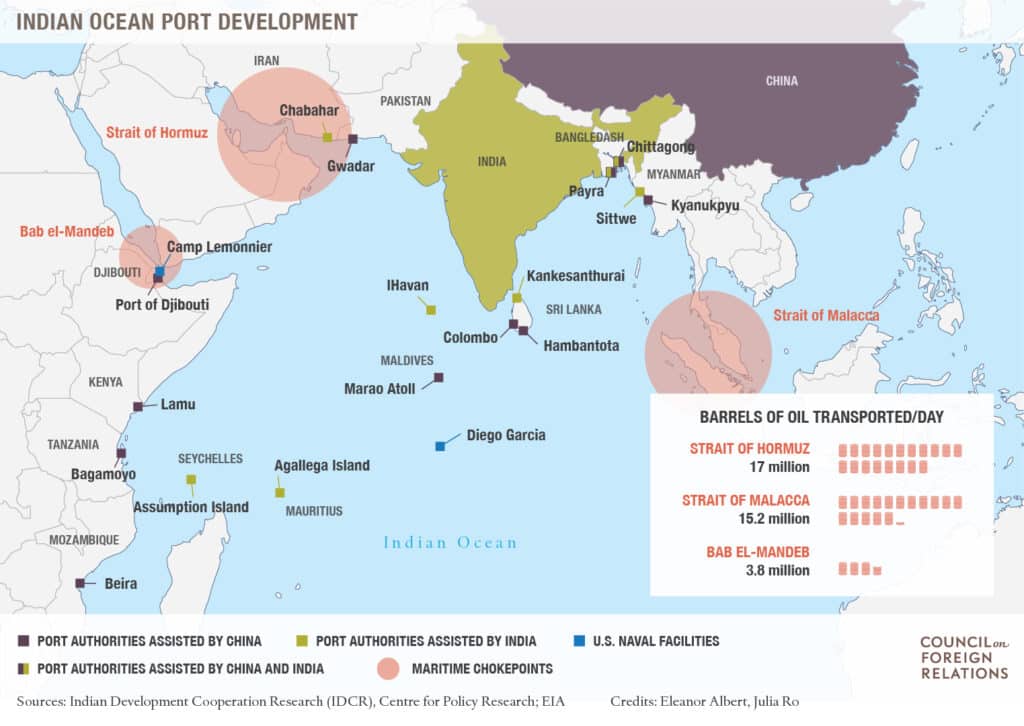
Role of India in Indian Ocean
Indian Ocean serves as a strategic bridge with the nations in India’s immediate and extended maritime neighbourhood. The national and economic interests of India are inseparably linked up with the Indian Ocean.
The role of India in the region is evident in its vision of ‘SAGAR ’, which means ocean and stands for “Security and Growth for all in the region”.
Net Security Provider
- The Indian Ocean has always enjoyed a place of prominence in global strategy. Many nations have established a presence in the region to ensure their strategic interests. However, India has always been a keen supporter to the cause of keeping the Indian Ocean a Zone of Peace.
- India’s new vision for maritime security is comprehensively articulated in “Ensuring Secure Seas: Indian Maritime Security Strategy”, a document by the Indian Navy which clarifies that the Indian Navy’s interest areas cover the Red Sea, Gulf of Oman , Gulf of Aden, IOR Island nations, Southwest Indian Ocean and East Coast of Africa littoral countries among many other nations and areas.
- The emergence of piracy and maritime terrorism has become one of the major threats to the stability in the region.
- Malabar Exercise and other bilateral exercises with countries like Indonesia and re-engaging with the Indian Ocean Region (IOR) and South Pacific, island nations signal India’s preparedness for a critical role in the region.
- India’s security efforts in the Indian Ocean have already begun to take concrete shape with the transfer of the Indian-made patrol vessel Barracuda to Mauritius, the deployment of P-8I aircraft to Seychelles for surveillance of its exclusive economic zone, the agreements to develop connectivity infrastructure in Agalega in Mauritius.
- India’s only ‘Tri-Service Command’ at Andaman and Nicobar Islands is working on expanding the military effectiveness of its outpost at the juncture of Bay of Bengal and Andaman Sea.
Humanitarian and Disaster Relief Operations
- India has been playing an active role in humanitarian and disaster relief operations. It not only rescued citizens of India, but also provided assistance to other countries.
- For example, Indian efforts have been extended to disaster relief in other countries, like assistance to Indonesia and Sri Lanka following the 2004 tsunami, to Myanmar after Cyclone Nargis, to Bangladesh after Cyclone Sidr, and to Sri Lanka after Cyclone Roanu.
- In 2014, under ‘Operation Neer’ India dispatched ‘water aid’ to the Maldivian capital of Male, after a fire destroyed the generator of its biggest water treatment plant.
Blue Economy
- To realise the blue economy potential, the Ministry of Shipping has launched the ‘Sagarmala Project‘, a strategic initiative for port-led development through the extensive use of IT enabled services for modernisation of ports.
- ‘Blue Economy’ is based on using locally available resources and employ renewable inputs that addresses the problems of resource scarcity and enables sustainable development.
- According to Niti Aayog, the development of Blue Economy can serve as a growth catalyst in realizing the vision to become a $10 trillion economy by 2032. As quoted by Hon’ble Prime Minister of India “Blue Chakra of India’s national flag represents the potential of the Blue Economy”.
Diaspora and Cultural Exchanges
- The Ocean of Churn: Merchants and artisans who settled in these regions over millennia brought with them their cultural ethos and traditions. The region accepted these visitors as their own and in turn, the fusion that arose saw the creation of amazing shared cultures, not bound by political boundaries or the monopoly of any single nation. The engagement of Indian Diaspora in the region through Pravasi Bharatiya Diwas is increasing their role in India’s growth story.
Space Technology
- NavIC: It stands for Navigation with Indian Constellation, which is India’s indigenous global navigation satellite system. The Indian Regional Navigation Satellite System (IRNSS) would be useful in land, sea and air navigation. The operationalization of NavIC will have significant implications for the whole of south Asian region. This will be especially handy during the natural and manmade disasters.
- South Asia Satellite or GSAT-9: The launch of the satellite will help to achieve effective communication;
better governance, better banking and better education in remote areas; more predictable weather forecasting, land monitoring and efficient resource mapping; linking people with top end medical services through telemedicine; and a quick response to natural disasters in the region.
Indian Ocean Policy
- The India Maritime Security Strategy published by the Indian Navy articulates country’s policy in the Indian Ocean region. It states that in the Indian Ocean region, India is committed to:
- Ensuring a safe, secure and stable Indian Ocean Region;
- Deepening security cooperation, through increased surveillance and monitoring with regional partners;
- Forging a multilateral cooperative maritime security initiative in the Indian Ocean to combat terrorism and piracy;
- Deepening cultural linkages with the people in region; and
- Building Indian Ocean Region as a frontier of sustainable economic development.
- India’s preparedness for its critical role in the region is seen in the Joint Strategic Vision with the US, Japan’s inclusion into the Malabar Exercise, bilateral exercises with countries like Japan, Australia and Indonesia, and signing of Mutual Logistics Support Agreements with US, France and Singapore.
- India’s Indian Ocean policy is centered on providing security and political stability to its “maritime neighbourhood”, which includes the Maldives, Mauritius, Seychelles and Sri Lanka, in the face of
China’s expanding naval and strategic activities in the Indian Ocean. - Project Mausam: It would allow India to re-establish its ties with its ancient trade partners and re-establish an “Indian Ocean world” along the littoral of the Indian Ocean.
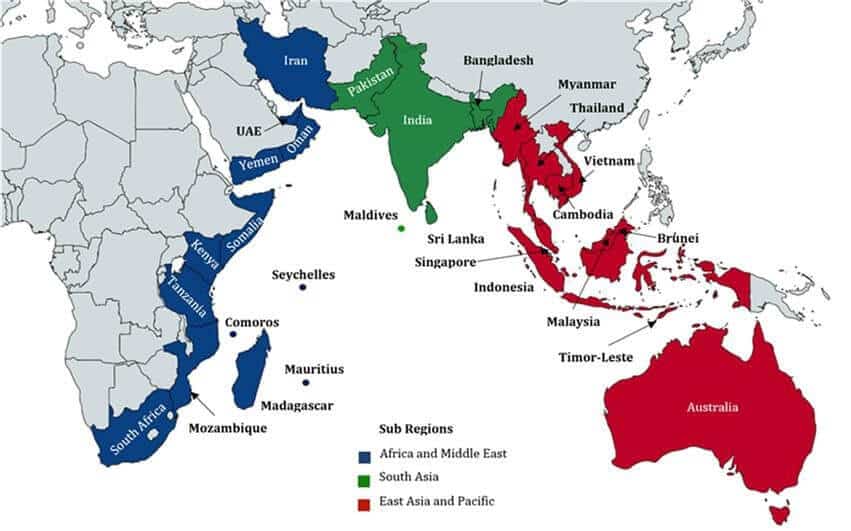
Regional Groupings in Indian Ocean
The region boasts of established regional organizations like SAARC, BIMSTEC, ASEAN, GCCin the Gulf, IORA, etc.
Indian Ocean Rim Association for Regional cooperation, also known as Indian Ocean Rim Association (IORA) is specifically dedicated to the Indian Ocean.
Indian Ocean Rim Association
- It is an inter-governmental organisation aimed at strengthening regional cooperation and sustainable development within the Indian Ocean region through its 23 Member States bordering the Indian Ocean and 10 Dialogue Partners.
- It was formed in 1997 and its secretariat is in Mauritius.
- The IORA is a regional forum, tripartite in nature, bringing together representatives of Government, Business and Academia, for promoting co-operation and closer interaction among them.
- It is based on the principles of Open Regionalism for strengthening Economic Cooperation particularly on Trade Facilitation and Investment, Promotion as well as Social Development of the region.
- The members include Australia, Bangladesh, Comoros, France, India, Indonesia, Iran, Kenya, Madagascar, Malaysia, Mauritius, Mozambique, Oman, Seychelles, Singapore, Somalia, South-Africa, Sri Lanka, Tanzania, Thailand, United Arab Emirates, Maldives and Yemen.
- Significance:
- Regional cooperation among IORA countries will become increasingly important in order to ensure the safety and security of vital trade routes, particularly the choke points.
- It will help India to ensure the freedom of navigation and over flight over the region.
- Issues related to Blue Economy and Piracy will be addressed to ensure maritime safety and security.
- The IORA provides an effective multilateral platform that facilitates realization of untapped opportunities for prosperity, peace and development of the region through greater interactions.
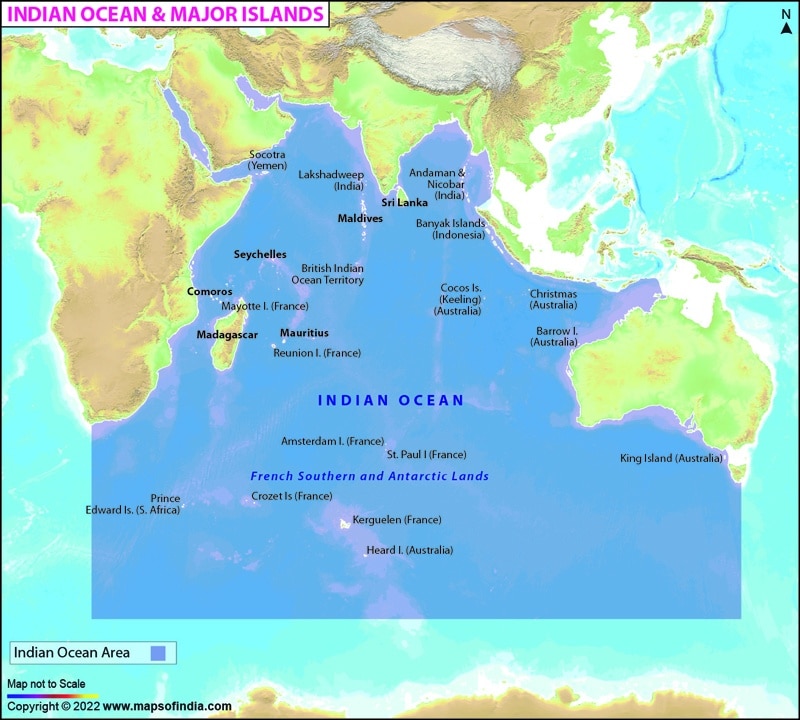
Challenges for India
The new Indian Maritime Security Strategy (IMSS- 2015) is an exposition of India’s nautical challenges, existing maritime practices, shifting technological trends, and evolving operational posture at sea. Recent developments in the IOR have given India’s security agencies reasons to be worried about the growing threats in the IOR.
Maritime Security (Terrorism, Piracy and Drug Trafficking)
- India will have to contend with non-state actors such as those who carried out the 2008 Mumbai attacks; and an arc of instability on the iOR periphery, which is the locus of problems such as Somali piracy, Makran coast drug trafficking and the ongoing conflict in Yemen, where India conducted a well-executed non-combatant evacuation operation (NEO), Operation Rahat, in April 2015.
- Migration and human trafficking in South and Southeast Asia too has registered a surge in numbers.
- For example, rise in refugee movement from Bangladesh and Myanmar (Rohingya Crisis) has resulted in a humanitarian crisis of unprecedented proportions.
Climate Change and Indian Ocean Region (IOR)
- Climate change may render the Indian Ocean nations vulnerable to stronger and more frequent and higher storm surges. Most people in IOR live in big coastal cities with large supporting infrastructure such as port facilities and oil refineries.
- In the event of a severe climate crisis, the risk of damage to coastal infrastructure – including naval docking and shore facilities – is very high.
- Submergence will cause loss of livelihood, migration, conflicts which may create crisis in the region.
- Monsoonal nature of Indian agriculture and other countries will be impacted by variability in weather patterns leading to loss of yield and farmer distress.
- Warming of ocean will impact fisheries sector and Coral ecosystem on which huge population of the region is dependent .
- The Alliance of Small Island States (AOSIS) which is a coalition of small island and low-lying coastal countries, share similar development challenges and their vulnerability to the adverse effects of global climate change. Comoros, Maldives, Mauritius and Seychelles are the members of this UN recognized intergovernmental grouping.
China’s Presence in Indian Ocean
- China’s aggressive soft power diplomacy has been the most important element in shaping the Indian Ocean strategic environment, transforming the entire region’s dynamics. By providing large loans on generous repayment terms, investments, offering military assistance and political support, China has secured considerable goodwill and influence among countries in the Indian Ocean region.
- China has become the largest lender of Sri Lanka replacing Japan. Kenya offers another example of
how China has been bolstering its influence in the Indian Ocean. - China’s submarine and surface forces are growing both qualitatively and quantitatively, and these forces are expanding operations beyond their traditional areas. Example: Docking of Chinese submarine at Hambantota Port, Sri Lanka.
- China through its presence of maritime silk road and developing of a Blue Water Navy with its aggressive
policy of expansion will pose a security threat to Indian Ocean as it has done in other Seas like South and East China sea.
Challenge Posed by Pakistan
- With regards to Pakistan, the establishment of a Naval Strategic Force Command in 2012 could portend a future in which Pakistan employs nuclear weapons at sea.
- State sponsored terrorist activities as well as other terrorist organisations based in Pakistan use Indian Ocean, as in Mumbai terror attack in 2008, to spread its terrorist activities.
- Pakistan’s move to acquire at least eight diesel submarines fitted with air-independent propulsion systems from China in the 2023-2028 time frame adds more uncertainty to this subsurface mix. Operational control over Pakistan’s Gwadar port will help China to encounter the Indian Navy directly.
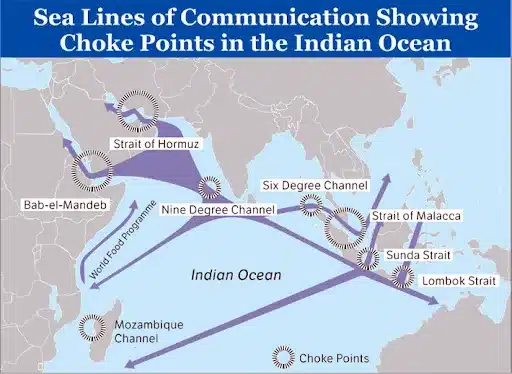
Way Forward
- The Indian Ocean Region needs a sustainable and inclusive framework for international partnerships. India
needs to further elevate, strengthen and deepen its security cooperation with regional partners such as Sri Lanka, the Maldives, Seychelles and Mauritius, as well as the United States, Japan and Australia to protect its core security interests in the Indian Ocean. - Notwithstanding recent maritime outreach to smaller island states, there still remains a space where the Indian navy’s aspiration of playing the net-security provider is yet to fully fructify.
- A strong impetus on Research and Development, and Innovation in the areas of Ocean Energy, Marine Biology and Biotechnology must be provided to achieve significant market shares in these sectors.
- Keeping in mind the Act East Policy, and envisaging the future scenario in the Indian Ocean region and
South-East Asia, the focus should be on developing the strategically located islands in Andaman and Nicobar. - Achieving these objectives will require further investments in capacity, greater transparency and confidence-building measures and enhanced institutional cooperation.
Conclusion
- The Indian Ocean is about people, culture and commerce. Appreciating its complex texture and intricate nuances is essential to nurture its growth and resurgence. It must be treated as a partner, not as an arena.
- Therefore, mutual trust and cooperation among the littoral countries will shape the stability and growth of the region.
